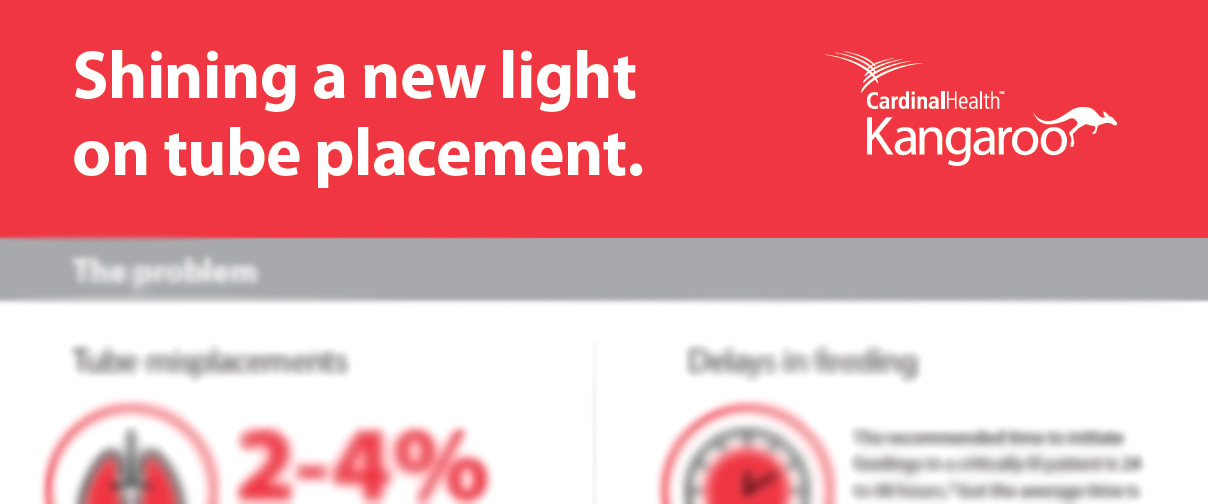Kangaroo™ Feeding Tube with IRIS Technology
Tube placement is a common blinded procedure that is done at bedside, yet one misplacement into the respiratory tract can lead to delayed nutrition delivery and increased hospital cost.
Did you know:
- Average bedside placement failure rate is: 12%1
- 2-4% of feeding tubes misplaced into the respiratory tract with serious injury.2
Introducing: Kangaroo™ Feeding Tube with IRIS Technology
We put a camera inside a small-bore feeding tube, so placers can feel confident about dropping feeding tubes at the bedside. Designed to reduce delays in feeding, Kangaroo™ IRIS takes a common, blinded procedure in a new and innovative direction.
Download our brochure and learn more about risk and challenges with tubes placed blindly at bedside and benefits of advanced placement technology »
Kangaroo™ IRIS is designed to help you:
The first feeding tube that comes with a view
The Kangaroo™ Feeding Tube with IRIS Technology is the first disposable feeding tube with a camera to visually aid in the placement of small-bore feeding tubes. This technology takes a common, blinded procedure in a new and innovative direction, supporting placement at the bedside.
Kangaroo™ IRIS is designed to help you:
- See anatomy real-time during feeding tube placement
- Safely and confidently position small-bore feeding tubes at the bedside
- Mitigate delayed feeding and expedite the delivery of nutrition to your patients
The Kangaroo™ Feeding Tube with IRIS Technology. Just one of the many ways Kangaroo™ is by your side.
Console
- 10.4" (26.4 cm) touch screen
- Still capture and exportability of saved images
- In-use battery life up to 4 hours
- 14 languages
Feeding Tube
- Integrated 3 mm camera at the distal tip of the tube
- Sizes: 8 Fr, 10 Fr and 12 Fr
- Lengths: 36" (91 cm), 43" (109 cm) and 55" (140 cm)
- ENFit™ connection
Interface Cable
- Still shot capture button
- 5' (1.5 meters) length for easy maneuverability
- Reusable for up to 5,000 connections
Insufflation Device
- Manual insufflation device to deliver air as needed during placement
- Delivers approximately 30 mL of air per squeeze
- Built-in pressure release valve
Kangaroo™ Feeding Tube with IRIS Technology Order Information
| Order Code | Description | Ship Case |
| 386100 | Kangaroo™ Console with Accessories (Global Power Adaptor, Battery, Interface Cable and Pole Clamp) | 1 |
| 460836E | Kangaroo™ Feeding Tube with IRIS Technology, 8 Fr x 36" (91 cm) | 5 |
| 460843E | Kangaroo™ Feeding Tube with IRIS Technology, 8 Fr x 43" (109 cm) | 5 |
| 460855E | Kangaroo™ Feeding Tube with IRIS Technology, 8 Fr x 55" (140 cm) | 5 |
| 461036E | Kangaroo™ Feeding Tube with IRIS Technology, 10 Fr x 36" (91 cm) | 5 |
| 461043E | Kangaroo™ Feeding Tube with IRIS Technology, 10 Fr x 43" (109 cm) | 5 |
| 461055E | Kangaroo™ Feeding Tube with IRIS Technology, 10 Fr x 55" (140 cm) | 5 |
| 461236E | Kangaroo™ Feeding Tube with IRIS Technology, 12 Fr x 36" (91 cm) | 5 |
| 461243E | Kangaroo™ Feeding Tube with IRIS Technology, 12 Fr x 43" (109 cm) | 5 |
| 461255E | Kangaroo™ Feeding Tube with IRIS Technology, 12 Fr x 55" (140 cm) | 5 |
Kangaroo™ Feeding Tube with IRIS Technology Accessories Order Information
| Order Code | Description | Ship Case |
| 388101 | Kangaroo™ IRIS Power Adapter | 1 |
| 388102 | Kangaroo™ IRIS Replacement Battery | 1 |
| 388103 | Kangaroo™ IRIS Interface Cable | 1 |
| 388104 | Kangaroo™ IRIS Mounting Clamp | 1 |
| 388105E | Kangaroo™ IRIS Insufflation Device | 5 |
| 388106 | Kangaroo™ IRIS Mounting Cart | 1 |
| 388107 | Kangaroo™ IRIS Battery Charging Station | 1 |


